 Deutsche Version
Deutsche Version
CAUTION
Sun observation IS potentially hazardous! Observation of the sun by inappropriate telescopes or optical equipment not intended for, may worst case cause IMMEDIATELY BLINDNESS!
The following description of modifications on my Coronado PST never should be used by persons without detailed knowledge about the operational principles of the PST and its internal filters.
I'm not responsible for anything, anything you do is on your own risk!
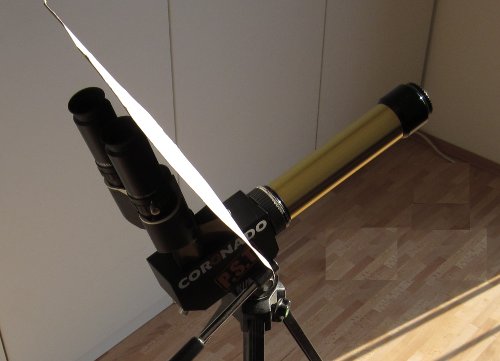 |
Overall picture: Actual version of my PST as of summer 2013 - Baader-Halpha-CCD Filter 35nm, 2", acting as ERF in front of the objective lens. Infrared blocked by additional 2" Schott KG3 filter. Eyepiece-sided tubing with original ERF removed. 10mm block filter from BF10. Baader binocular with 1.5x Barlow lens corrector. 40mm Plössl eyepieces. Sun shield howebrewed from black and white cardboard and brass clamp. Individual modifications are described in more detail below. Update: due to "construction activity" I hadn't much time for sun observation in 2012. As of summer 2013 the situation bettered. The whole IR subject made me do some improvement (see below). |
|
During my ATT 2010 visit in Essen (Germany) I got a Baader binocular at a nearly crazy price. Immediately I decided to put it into my PST. First try about was with help of a 3x Barlow lens, but... the resulting magnification was way too large. However, just one view through the bino left me with one thought which is well-known to all bino owners: "never again without it...". Since I bought my PST in 2006 its warranty was nearly over. Thus I decided to take it apart. I knew about the oil filter tool trick but that didn't work for me. Instead I found out an old leather belt gripped by pipe tongs will help to unscrew everything without leaving a single scratch on it. The photo on the right side shows the components of the PST. The "new" layout the objective lens no longer has an ERF coating on it; instead there is a small 15mm ERF in the small pipe between the eyepiece holder and the PST "box". Thus the small pipe must not simply be removed to gain some more focus range! If doing so nevertheless, one MUST take care of another proper ERF in front of the objective lens. I guess doing the latter also will make the etalon's life happier and longer. In unmodified newer PSTs all the unfiltered light energy (and that's a lot!) from the sun passes through the etalon filter. |
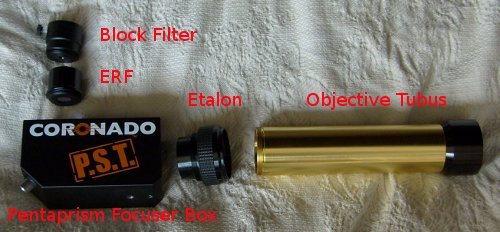 |
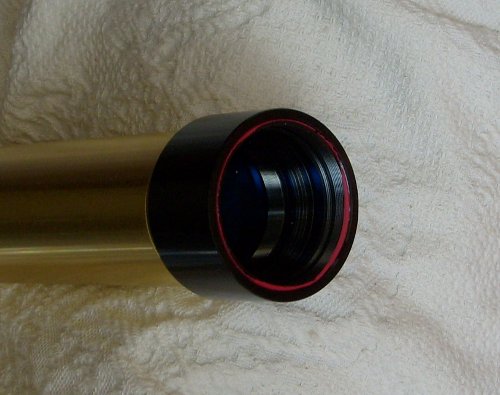 |
As a new ERF a 2" Baader filter is used (see below for details). The question was how to fit this to the M52 thread at the PST's objective. Couldn't find any adapters so I had to homebrew something: a short piece of threaded 2" eyepiece tubing was wrapped with adhesive tape and pressed into the PST objective thread (see left). The photo still shows a bit of the red adhesive tape (filter not yet mounted). In the end I had a 2" filter thread in front of the PST objective lens. The Baader filter of my choice is a 2" Halpha CCD filter with 35nm pass band. If the transmission diagrams on the Baader page are compared, it is slightly better than a C-ERF. It blocks outside of the pass band down to 0.1% (info from another website, I lost the link, sorry). The latter corresponds to ND 3 which is important in the infrared because the Coronado block filter is, well, very open in this wavelength range. See diagrams at sonnen-filter.de (german). To be on the secure side I made some tests on my own. I have a medical heat lamp which warms up skin very fast in 30cm distance. Putting the Baader filter in between, the sensation of heat on the skin stops - at least at a first glance. Of course, red light still passes the filter. In my little laser lab I also have a quite powerful infrared laser which I took for some measurements at 810nm wavelength. Result was a transmission of 3 * 10-4 - that's quite dark (approx. density 3.5). As turned out in the meantime, beyond 1400nm wavelength a good amount of infrared radiation still passes the Halpha filter. See below. |
|
Here we have a picture of the whole ERF mod: the Baader Halpha in front of the objective lens, the small ERF pipe below the eyepiece holder removed. At this 2010 photo the additional KG3 filter still misses. The gain in focusing length is sufficient to reach focus with the bino and a 1.5x Barlow screwed into its 1.25" adaptor. First view through the eyepiece showed a very obvious advantage: a strong reflection from the removed original ERF was gone. The reflection of the Baader filter was much much weaker and far away from the sun's image. I found out there are also disadvantages about this configuration. The original 5mm block filter was designed to let just the sun's image pass near the focus. Now, closer to etalon and objective lens, it cuts away part of the light cone. Thus, the field of view shows signs of degradation if not watching sun's surface close to the optical axis. Near the border of the field of view, resolution and Halpha detail suffer dramatically (but see below for a fix). A minor disadvantage: the bino at a 90 degree angle absorbs lots of sunrays and quickly becomes warm. |
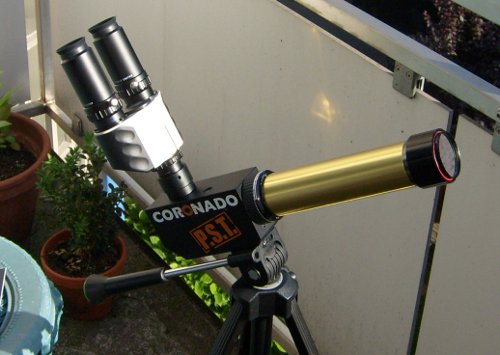 |
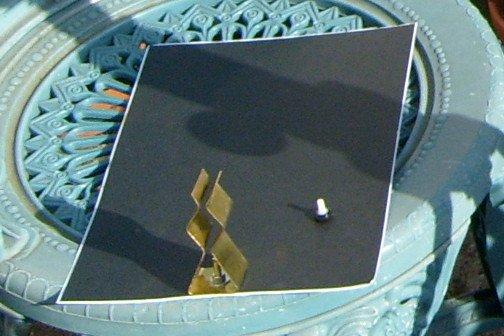 |
The sunray problem is easiest to be fixed: use a shield. Two pieces of black and white cardboard (size about a normal letter) glued to each other. A clamp can be made from a sheet of brass bended like a big version of an electrical micro fuse holder. Glue or use a screw to fix the clamp to the shield. The brass clamp then is put to the eyepiece holder of the PST (see first photo on this website). Take care for the little nylon screw on the eyepiece holder! |
|
The problem about the small 5mm block filter didn't let me sleep. I decided to go for a bigger one and purchased a used Coronado BF10. Despite of its name the Coronado block filters used with the Solarmax etalon filters, don't consist of a block filter only. There's also an additional filter into it (like it is in the newer PSTs eyepiece end, 15mm diameter). Fortunately, the true block filter part has exactly the same mechanical dimensions for both PST and BF10 so it can be swapped without any problem. Note that the latter is not the case for the additional filter which is inside the 1.25" tubing at the BF10 - too small for PST. Now the field of view of the Baader Bino with two 40mm eyepieces fits very well to the size of the 10mm block filter aperture. Over all the field there are again rich Halpha structures and full resolution. In the end I have a wonderful PST with 10mm block filter - and a complete (and surplus) Coronado BF5... :) |
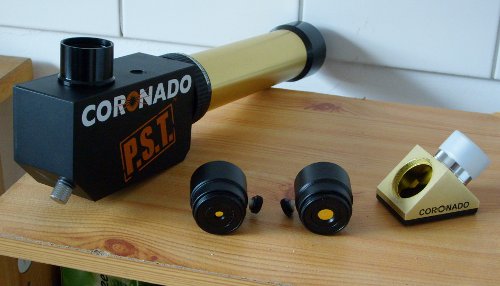 |
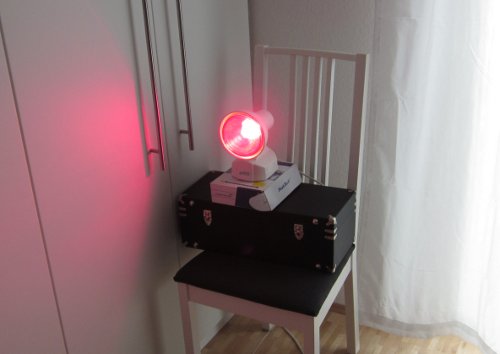 |
A different problem than the BF made me worry, too. There's no more any IR blocking. The last year there was a lot of discussion about this in certain websites. I for myself didn't get any problem with it (at least no serious). My eyes are examined on a yearly basis due to my job. I have no other problem than a slight hyperopia which is because im growing older. The lack of IR problems may be caused by the fact I used the PST only in conjuction with the binocular. So, any IR is dived by two each eye getting one half. The usual Halpha filters, be it for CCD or a true D-ERF, block only up to 1400nm. Beyond that, they pass about 50% of the total power. See e.g. sonnen-filter.de. Starting at 2500nm absorption of BK7 glass used in many optical components plays a major role. In between, there are absorption bands of water vapor in the earth's atmosphere, so not the full IR solar radiation passes it. But two peaks about at 1500nm-1800nm and 1900nm-2400nm are still present. Under ideal circumstances here we get about 100 W/m2 from the sun. Maybe that results in not much problem for the small 40mm PST objective lens. Radiation beyond 1400nm doesn't reach the eye's retina but is absorbed in the cornea, lens and the vitreous body. But especially for larger objective mods there is no way around an additional infrared blocker. This was the reason I purchased a 2" Schott KG3 filter from Oliver Smie. Seems to be an eternal rule that getting new parts for your telescope means it rains for days when they arrive... thus I again abused my medical red light lamp as a sun simulator. Besides of a bit visible red (of course including 656.28nm) it emits nearly all of its power in infrared. Thus it is quite suitable for measurements at objective tube and the 2" filters. See it in the photo in action. Of course its spectral power distribution doesn't match that of the sun. |
|
Here the PST objective tubus is under test in my laser lab. Leftmost my homegrown laser power meter, made out of a peltier and calibrated against a commercial laser power meter (done that on the LaserFreak meeting in 2011 at Essen, Germany). The red scattered light is the artifical "sunshine". Image of the medical red light lamp is projected onto the sensor (at least by part). In front of the tubus the two 2" filters wait to be tested. The result was quite clear. The PST objective lens alone projected a power of 32.5mW into the sensor. Using the KG3 filter in front of the lens this reduced to about 1.8mW. The Halpha filter plus lens resulted in 11mW in the sensor -- oops! Both filters and lens together let only 1mW pass through. Looks like the PST objective lens has no particular IR protection at all. Did the same test setup again with the really ancient 60mm objective lens of my very first telescope which had never any coatings. Reduced to 40mm aperture it gave the same overall result (the absolute readings differed somewhat due to the larger focal length of the lens). Conclusion: we better use a IR block filter. :o |
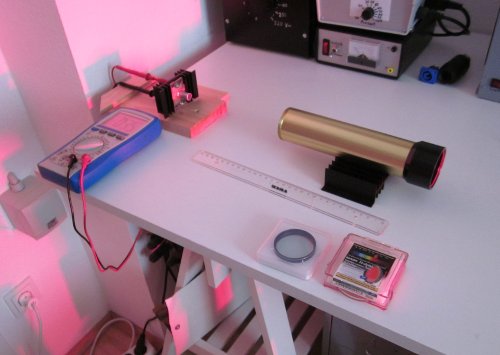 |
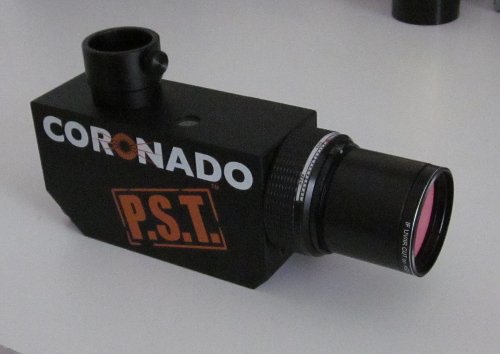 |
This picture shows the future of my PST: it will act as a plug-in Halpha module for a larger telescope. Objective sided a 2" adaptor which also carries the KG3 infrared blocker. Eyepiece side is shortened and with BF10 block filter, prepeared to take my binocular. Used with a proper D-ERF in front of the telescope objective I can go to larger apertures without risking to "cook" my eye's vitreous bodies. |
Future plans...
Lately I found a reference about a PST mod using a Celestron C6. I like that idea for its short overall length. However, it needs a 150mm D-ERF in front of the objective. The price for this thingie might become a true show-stopper. :/
You see: story has to be continued. Stay tuned...